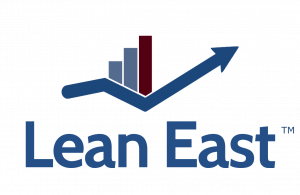
The end of the year is a popular time for strategic planning and establishing goals for the year ahead. We have seen many clients struggle with setting goals, so we want to share six ways to develop both organizational and individual improvement goals. Read below to see if the method you use for goal setting is shared – and if it isn’t, please share your preferred way with the Lean East team and other readers by leaving a comment.
Lean East’s Strategic Planning Process
Lean East President Steve Musica has facilitated many Strategic Planning events for clients over the past several years. If clients don’t already have an established process, we typically use the Lean East PERFORMANCE™ Process to set our agenda.
A key to the PERFORMANCE™ Process is setting goals and measures of success around the vision you have for the future. Your vision and goals become the “rocks” that you need to prioritize. Regularly reviewing the status of your rocks is the foundation of a great management team meeting. Learn more about goal setting and the secrets of being productive in our book summary of Smarter Faster Better.
Six Ways to Set Goals
Now that you understand the importance of setting annual goals, here are six ways you can create your goals for the New Year. Can you guess which method Lean East uses in our annual planning?

- SMART Goals: This classic method involves setting goals that are Specific, Measurable, Achievable Actions, Relevant, and Time-bound. This ensures clarity, focus, and accountability.
- OKRs (Objectives and Key Results): This framework helps you set ambitious goals (Objectives) and track progress towards them using measurable Key Results. It encourages a balance of innovation and execution.
- End of Year Vision Exercises: Envision it is the end of next year and you have met your goals. How did you do this? Envision what would need to transpire for this. Now turn those visions into reality.
- Mind Mapping: Begin by drawing your central goal or desired result in the center of a blank page or whiteboard and branch out into images of smaller, actionable steps. This method uses the creative right half of your brain and helps you break down large goals into manageable chunks. Here is an example of a mind map from a Lean East book summary.
- Focus on Systems, not Goals: Instead of focusing on outcome goals, work on building systems that support your long-term vision. In other words, every team has the goal of winning the championship. Success arises from systems that build the best team, best strategies, and adjust the best. Make your goal to use and improve three key systems in the new year.
- Start, Stop, Continue: “You are what you repeatably do.” Consider the three daily habits you want to start in the new year, three you want to stop, and three habits you want to continue. Focusing your goals on daily habits may help you make more progress than setting outcome goals.
Set Goals Based on Roles
It is important to consider roles for all six ways of goal setting shared above. Roles apply to organizations and individuals and will help you ensure balance when setting your goals.
Organizational goals are often set in a strategic planning retreat by a cross-functional leadership team. This ensures consideration of your vision and goals from multiple viewpoints and perspectives. But what if you are setting goals as a small team or an individual? Here, you need to ensure a cross-functional view of your goals in a different way.
We like basing goals on the key roles in an organization. If these roles are represented by people in your strategic planning, then you are set. If not, consider goals for the coming year from each of these perspectives:

- CEO – main, most important goal
- CFO – Financial related goals
- COO – Operations/production/service/quality/execution-related goals
- Sales – Customer acquisition goals
- Marketing – Advertising and marketing goals
- Human resources – Hiring, people, and culture goals
- IT – Technology and systems goals
Feel free to consider goals from different or additional perspectives if they are important to your organization.
Individuals Should also Set Goals Based on Roles
I always set my personal goals for the year based on my roles as an individual. Some of my individual roles are as a:
- Spouse – partner
- Parent
- Relative (sibling, brother, etc.)
- Homeowner
- Volunteer
- Employee – Worker
- Healthy person
- Learner
Consider goals based on each of these roles (adjusting roles to your own situation). For example, in my role as a parent, I will consider creating SMART goals related to my kids.
Summary
If the method(s) you use for goal setting weren’t shared above, please share your preferred way with the Lean East team and other readers by leaving a comment. You can also guess which method(s) the Lean East team uses for goal setting. We will share a gift with anyone who shares the correct answer.


Related Posts
The God Complex: Why We’re All Making This One Mistake
How I am Changing the Career Advice I Give My Kids
This is Never Going to Work: Getting Lean Projects Unstuck